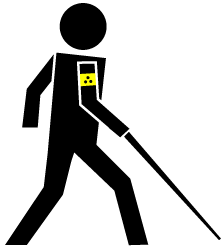1.1.3. Space Perception
Definition of Space Perception
"Space perception is a process through which humans and other organisms become aware of the relative positions of their own bodies and objects around them. Space perception provides cues, such as depth and distance, that are important for movement and orientation to the environment. " (Encyclopedia Britannica)
Humans perceive their environment with various senses. The following senses are responsible for the space perception:
- Sight
- Hearing
- Touch
- Smell
Perception is important for our sense of orientation. Without perception
we would not be able to orientate us in the environment and without orientation
we are not able to navigate through the space. Therefore, perception is the
basis for navigation.
The following paragraphs introduce the four
senses that are responsible for space perception. Examples illustrate the use of
the senses in real space.
Sight
|
The most important sense for orientation is the sight. You see
objects and you are geared to them. Especially when being on the way and
looking for a specific route or destination you orientate yourselve
using your eyes. |
Navigation with the eyes (Wipf 2006) |
Hearing
|
You perceive with your ears as well. The nature is full of
sounds: Ripple of water, singing birds, chirping crickets, ringing
church bells, engine noise of the cars, etc. Each sound defines a
special area. For example hearing the engine noise of cars means that a
street must be very close, the ringing of the church bells are a sign
for a near village, etc. The direction where the sound comes from
indicates the location of the area. |
Navigation with the ears |
Smell
The nature is not only full of sounds but also full of odours. You can
for example smell the odour of a barbecue or of a bakery from a distance. When
you smell such an odour you know that the origin of the odour must be quite
close to you. Perhaps you can also identify the direction where the odour comes
from.
Because we cannot visualise odours with the computer we count on
your imagination for the next example. It shows a small extract of a village.
There are three squares marked with red strokes. Move the mouse cursor over
these squares to view the odours that are hidden behind these objects. All these
odours are perceivable several meters away from the objects.
Touch
|
Perhaps you sometimes do not realise it but you orientate
yourselve often with touching. Most of the time, you touch with your
hands to guess an object, but your feet as well give feedback about the
features of an object. For example feeling a hard surface under your
feet gives you the security to be on a stony ground. You do not know if you
are on a man-made street or a natural rock, but you know for sure that
you are NOT in the meadow. |
 Navigation with touch Navigation with touch |
The ears, the touch and the smell are the most important
senses for visually impaired people since they cannot or can hardly use their
eyes.
Orientation Problems
Orientation problems arise whenever our surroundings have very few objects which can be used to get our bearings, for example on unknown terrain, in darkness, in the desert or at sea. To be able to orientate us in such terrains, different navigation techniques with different tools emerged. (Studio 7.5 2002)
One of those tools is the map which is a miniature and abstract portrayal of reality (Studio 7.5 2002). They help us to get our bearings because they show the world from a bird's eye view. The next chapter introduces more tools that are used for navigation.
